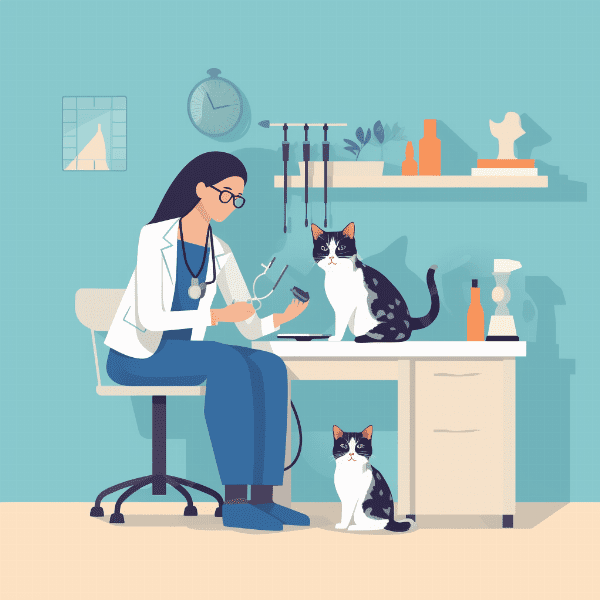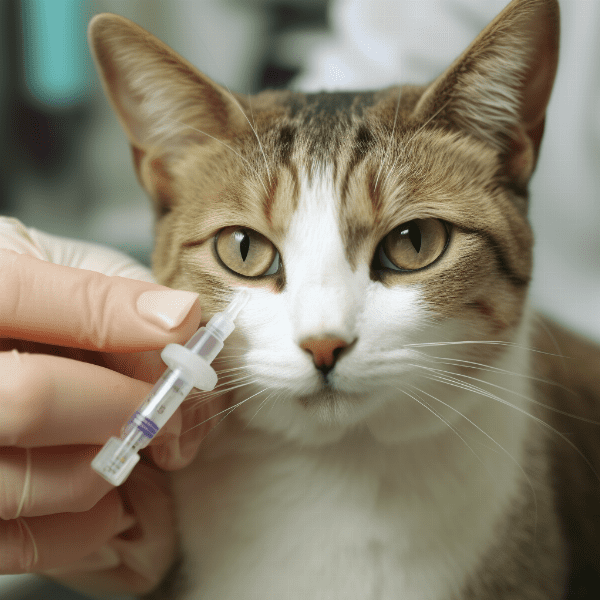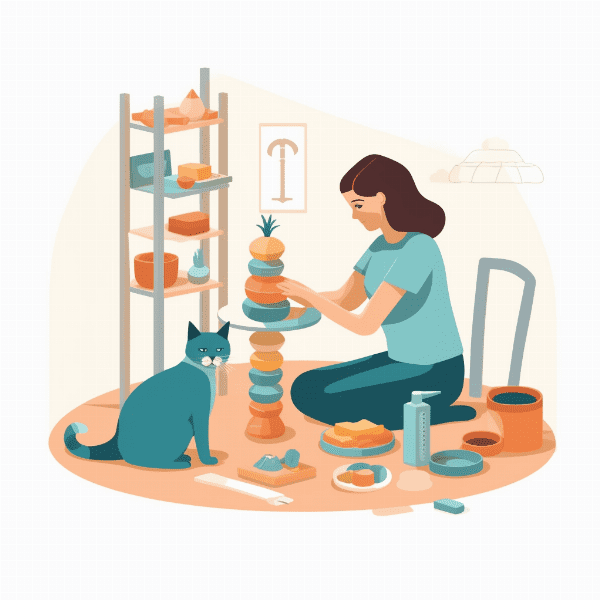Table of Contents
- Understanding High Blood Sugar in Cats
- Recognizing the Symptoms of High Blood Sugar in Cats
- Diagnosis and Treatment Options for Feline Diabetes
- Creating a Proper Diet Plan for Cats with High Blood Sugar
- The Importance of Exercise and Weight Management for Diabetic Cats
- Monitoring Blood Sugar Levels and Regular Veterinary Check-ups
- Managing Insulin Injections and Oral Medications for Feline Diabetes
- Tips for Making Lifestyle Changes Easier for You and Your Cat
- Dealing with Potential Complications of High Blood Sugar in Cats
- Support and Resources for Cat Owners Managing Feline Diabetes
Understanding High Blood Sugar in Cats
High blood sugar, also known as hyperglycemia, is a common health problem in cats. It occurs when there is an excess amount of glucose in the bloodstream that cannot be efficiently utilized by the body’s cells. Unlike humans, cats are unable to control their blood sugar levels through dietary changes alone, and therefore, the condition must be closely managed with proper veterinary care.
Causes of High Blood Sugar in Cats
There are several potential causes of High blood sugar in cats, with the most common being feline diabetes. This condition occurs when the pancreas does not produce enough insulin, the hormone responsible for regulating blood sugar levels. Other possible causes of hyperglycemia in cats include hormonal imbalances, medications, infections, and certain medical conditions such as pancreatitis and hyperthyroidism.
Risk Factors for Feline Diabetes
While any cat can develop feline diabetes, certain breeds are at a higher risk than others. Burmese and Siamese cats, for example, are more susceptible to the condition. In addition, overweight cats and those with a sedentary lifestyle are more likely to develop diabetes. Age is also a factor, with cats over the age of 10 being at a higher risk.
Symptoms of High Blood Sugar in Cats
Recognizing the signs of hyperglycemia in cats is important for early diagnosis and treatment. Symptoms may include increased thirst and urination, weight loss, lethargy, and decreased appetite. In severe cases, cats may experience vomiting, dehydration, and even coma.
Potential Complications of High Blood Sugar in Cats
If left untreated, high blood sugar can lead to several serious health complications in cats, including nerve damage, kidney failure, and blindness. It can also weaken the immune system, making cats more vulnerable to infections and illnesses.
Understanding the causes, risk factors, symptoms, and potential complications of high blood sugar in cats is essential for effective management and treatment. If you suspect that your cat may be suffering from hyperglycemia, seek veterinary care immediately to ensure the best possible outcome for your furry friend.

Recognizing the Symptoms of High Blood Sugar in Cats
Recognizing the symptoms of high blood sugar in cats is crucial for early detection and treatment of the condition. While some cats may display no symptoms at all, others may exhibit several signs that something is amiss.
Increased Thirst and Urination
One of the most common symptoms of high blood sugar in cats is increased thirst and urination. Cats with hyperglycemia may drink excessive amounts of water and urinate more frequently than usual. This is because the kidneys are working overtime to eliminate excess glucose from the bloodstream.
Weight Loss
Cats with high blood sugar may experience weight loss despite an increased appetite. This is because their bodies are unable to properly utilize the glucose in their food as a source of energy, leading to the breakdown of fat and muscle tissues.
Lethargy and Weakness
Cats with hyperglycemia may also appear lethargic and weak, as their cells are not receiving the energy they need to function properly. This can lead to a lack of interest in playtime or other activities, and a general feeling of malaise.
Decreased Appetite
While some cats with high blood sugar may exhibit an increased appetite, others may actually eat less than usual. This can be due to nausea or discomfort in the digestive tract, which can be caused by the excess glucose in the bloodstream.
Vomiting and Dehydration
In severe cases, high blood sugar can lead to vomiting and dehydration. This can occur when the body attempts to rid itself of excess glucose through the digestive tract, leading to vomiting, and loss of fluids.
Recognizing the symptoms of high blood sugar in cats is critical for early diagnosis and treatment. If you notice any of these signs in your cat, seek veterinary care immediately to prevent potential complications and ensure the best possible outcome for your furry friend.

Diagnosis and Treatment Options for Feline Diabetes
Diagnosing and treating feline diabetes requires close collaboration between cat owners and their veterinarians. With proper veterinary care, cats with diabetes can lead long and healthy lives.
Diagnosis of Feline Diabetes
To diagnose feline diabetes, veterinarians will typically perform a thorough physical examination, including blood and urine tests. Blood tests can determine the cat’s blood sugar levels and the presence of ketones, which can indicate that the body is breaking down fat for energy. Urine tests can reveal the presence of glucose and ketones in the urine.
Treatment Options for Feline Diabetes
The treatment of feline diabetes involves a combination of lifestyle changes and medication. The goal of treatment is to regulate the cat’s blood sugar levels and prevent potential complications.
Insulin Therapy
Insulin therapy is the cornerstone of feline diabetes treatment. The type of insulin and dosage will vary depending on the cat’s individual needs. Some cats may require daily insulin injections, while others may only need injections once or twice a week.
Dietary Changes
Dietary changes are also an essential part of managing feline diabetes. Cats with diabetes require a balanced diet that is low in carbohydrates and high in protein. Feeding small, frequent meals throughout the day can also help regulate blood sugar levels.
Exercise and Weight Management
Exercise and weight management are crucial for cats with diabetes. Exercise can help improve insulin sensitivity and regulate blood sugar levels. Additionally, maintaining a healthy weight can help reduce the cat’s insulin requirements.
Monitoring Blood Sugar Levels and Regular Veterinary Check-ups
Monitoring blood sugar levels and regular veterinary check-ups are essential for managing feline diabetes. Cat owners should regularly monitor their cat’s blood sugar levels at home with a glucose meter and keep a record of the results. Regular veterinary check-ups can help ensure that the cat’s treatment plan is working correctly and make any necessary adjustments.
Diagnosing and treating feline diabetes requires a comprehensive approach that includes proper veterinary care, medication, dietary changes, exercise, and monitoring. With the right treatment plan and close collaboration with their veterinarians, cat owners can help their furry friends manage the condition and live happy, healthy lives.

Creating a Proper Diet Plan for Cats with High Blood Sugar
Dietary changes are an essential part of managing high blood sugar in cats. Feeding cats a balanced diet that is low in carbohydrates and high in protein can help regulate blood sugar levels and prevent potential complications. Here are some tips for creating a proper diet plan for cats with high blood sugar.
Choose a High-Protein, Low-Carbohydrate Diet
Cats with high blood sugar require a diet that is low in carbohydrates and high in protein. This is because carbohydrates are converted into glucose in the body, which can cause blood sugar levels to spike. Feeding your cat a high-protein diet can help regulate blood sugar levels and promote muscle growth.
Feed Small, Frequent Meals
Feeding your cat small, frequent meals throughout the day can help regulate blood sugar levels and prevent spikes. This is because smaller meals are easier for the body to digest and process, which can help keep blood sugar levels stable.
Avoid High-Fat Foods
While a moderate amount of fat is essential for a cat’s diet, high-fat foods can lead to weight gain and insulin resistance. Avoid feeding your cat high-fat foods, such as fatty meats and dairy products.
Monitor Your Cat’s Weight
Monitoring your cat’s weight is crucial for managing high blood sugar. Cats that are overweight or obese are at a higher risk for developing feline diabetes and other health problems. Speak with your veterinarian about a healthy weight range for your cat and monitor their weight regularly.
Creating a proper diet plan for cats with high blood sugar is essential for managing the condition and preventing potential complications. By working closely with your veterinarian and making dietary changes, you can help your furry friend live a happy and healthy life.

The Importance of Exercise and Weight Management for Diabetic Cats
Exercise and weight management are crucial for cats with high blood sugar. Regular exercise can help improve insulin sensitivity and regulate blood sugar levels, while weight management can reduce the cat’s insulin requirements and prevent potential complications. Here’s why exercise and weight management are so important for diabetic cats.
Benefits of Exercise
Exercise offers several benefits for cats with high blood sugar. Regular exercise can help improve insulin sensitivity, which means that the body can use insulin more effectively to regulate blood sugar levels. Exercise can also help promote weight loss and improve cardiovascular health, which can reduce the risk of complications such as heart disease and stroke.
Types of Exercise for Cats
While cats may not be as active as dogs, there are still several ways to encourage exercise. Playing with toys, such as balls or laser pointers, can help cats burn off excess energy and promote physical activity. Providing a cat tree or other climbing structure can also encourage cats to be more active and engage in natural behaviors such as climbing and jumping.
Benefits of Weight Management
Maintaining a healthy weight is crucial for cats with high blood sugar. Cats that are overweight or obese are at a higher risk for developing diabetes and other health problems. Weight management can also reduce the cat’s insulin requirements and prevent potential complications such as nerve damage, kidney failure, and blindness.
Tips for Weight Management
To maintain a healthy weight, it is essential to provide your cat with a balanced diet and monitor their food intake. Feeding small, frequent meals throughout the day can help regulate blood sugar levels and prevent overeating. It is also important to provide your cat with plenty of opportunities for exercise and playtime to help burn off excess energy.
Consult with Your Veterinarian
Before beginning any exercise or weight management program for your cat, it is crucial to consult with your veterinarian. Your veterinarian can help you determine the best exercise plan and recommend appropriate portion sizes and feeding schedules for your cat’s individual needs.
Exercise and weight management are essential for managing high blood sugar in cats. By providing your cat with opportunities for exercise and maintaining a healthy weight, you can help regulate their blood sugar levels and prevent potential complications.

Monitoring Blood Sugar Levels and Regular Veterinary Check-ups
Monitoring blood sugar levels and regular veterinary check-ups are essential for managing high blood sugar in cats. Regular monitoring can help detect changes in blood sugar levels and prevent potential complications. Here’s why monitoring and regular check-ups are so important for diabetic cats.
Home Monitoring
Home monitoring of blood sugar levels is an essential part of managing high blood sugar in cats. Using a glucose meter and test strips, cat owners can monitor their cat’s blood sugar levels at home and keep a record of the results. This can help detect changes in blood sugar levels and ensure that the cat’s treatment plan is working effectively.
Regular Veterinary Check-ups
Regular veterinary check-ups are also crucial for managing high blood sugar in cats. During a check-up, the veterinarian will perform a physical examination and may perform blood and urine tests to monitor the cat’s blood sugar levels and overall health. Regular check-ups can help detect changes in blood sugar levels and prevent potential complications such as nerve damage, kidney failure, and blindness.
Adjusting the Treatment Plan
Monitoring blood sugar levels and regular check-ups can help cat owners and their veterinarians adjust the cat’s treatment plan as needed. If blood sugar levels are not well-controlled, the veterinarian may adjust the cat’s medication dosage or recommend changes to the cat’s diet or exercise plan.
Signs of Hypoglycemia
Monitoring blood sugar levels and regular veterinary check-ups are essential for managing high blood sugar in cats. By working closely with their veterinarians and monitoring their cat’s blood sugar levels at home, cat owners can help prevent potential complications and ensure that their furry friends are receiving the best possible care.

Managing Insulin Injections and Oral Medications for Feline Diabetes
Managing insulin injections and oral medications is a crucial part of treating feline diabetes. Consistent and correct administration of medications can help regulate blood sugar levels and prevent potential complications. Here’s what cat owners need to know about managing insulin injections and oral medications for feline diabetes.
Insulin Injections
Insulin injections are the most common form of medication used to treat feline diabetes. Cat owners will need to administer insulin injections to their cats as directed by their veterinarian. It is important to follow the veterinarian’s instructions carefully, as giving too much or too little insulin can lead to potentially life-threatening complications.
Storage of Insulin
Insulin should be stored in a cool, dry place, such as the refrigerator. It should never be frozen or exposed to direct sunlight. Before administering insulin, it should be brought to room temperature to ensure that it is evenly distributed.
Oral Medications
While insulin injections are the most common form of medication for feline diabetes, some cats may be prescribed oral medications. These medications work by stimulating the pancreas to produce more insulin or by making the body more sensitive to insulin. Cat owners should follow their veterinarian’s instructions carefully and administer the medication as directed.
Monitoring Blood Sugar Levels
Monitoring blood sugar levels is essential when managing insulin injections and oral medications for feline diabetes. Regular monitoring can help detect changes in blood sugar levels and ensure that the cat’s treatment plan is working effectively. Cat owners should use a glucose meter and test strips to monitor their cat’s blood sugar levels at home, as directed by their veterinarian.
Adverse Reactions
Cat owners should be aware of the potential adverse reactions to insulin injections and oral medications. Signs of an adverse reaction may include vomiting, diarrhea, lethargy, and loss of appetite. If cat owners notice any of these signs, they should seek veterinary care immediately.
Managing insulin injections and oral medications is an essential part of treating feline diabetes. By working closely with their veterinarians, monitoring blood sugar levels regularly, and administering medications correctly, cat owners can help regulate their cat’s blood sugar levels and prevent potential complications.

Tips for Making Lifestyle Changes Easier for You and Your Cat
Managing high blood sugar in cats requires making lifestyle changes for both the cat and their owner. While these changes may seem daunting at first, there are several tips and tricks to make the process easier for both you and your furry friend.
Start Slowly
Making sudden and drastic changes to your cat’s diet or exercise routine can be overwhelming for both you and your cat. Instead, start by making small changes over time. For example, gradually switch to a new type of cat food or gradually increase the length and intensity of your cat’s exercise routine.
Be Consistent
Consistency is key when it comes to managing high blood sugar in cats. Try to maintain a consistent feeding and exercise schedule to help regulate your cat’s blood sugar levels. Additionally, be consistent with medication administration and monitoring blood sugar levels.
Use Positive Reinforcement
Positive reinforcement can be an effective way to encourage your cat to make lifestyle changes. Reward your cat with treats, toys, or affection when they exhibit desired behaviors, such as eating a healthy meal or engaging in physical activity.
Find Fun Ways to Exercise
Exercise doesn’t have to be boring for your cat. Find fun and interactive ways to engage your cat in physical activity, such as playing with toys or providing a climbing structure. This can help make exercise more enjoyable for your cat and encourage them to engage in more physical activity.
Make Dietary Changes Gradually
Switching to a new diet can be challenging for cats, especially those who are picky eaters. To make dietary changes easier, introduce new foods gradually and mix them with familiar foods to help your cat adjust to the new taste and texture.
Seek Support from Your Veterinarian
Your veterinarian can provide valuable support and guidance throughout the process of managing high blood sugar in your cat. Don’t hesitate to ask for advice and support when making lifestyle changes for your furry friend.
Making lifestyle changes for managing high blood sugar in cats can be challenging, but with the right approach, it can also be rewarding. By starting slowly, being consistent, using positive reinforcement, finding fun ways to exercise, making dietary changes gradually, and seeking support from your veterinarian, you can help your cat live a happy and healthy life.

Dealing with Potential Complications of High Blood Sugar in Cats
While managing high blood sugar in cats is important, it is also essential to be aware of potential complications that may arise. Here are some common complications of high blood sugar in cats and how to deal with them.
Hypoglycemia
Hypoglycemia is a condition in which blood sugar levels drop too low. This can be caused by giving too much insulin or not feeding the cat enough. Signs of hypoglycemia may include lethargy, weakness, seizures, and coma. If you notice any of these signs, seek veterinary care immediately.
Ketoacidosis
Ketoacidosis is a potentially life-threatening complication of high blood sugar in cats. It occurs when the body breaks down fat for energy instead of glucose, resulting in the accumulation of toxic ketones in the bloodstream. Signs of ketoacidosis may include lethargy, vomiting, dehydration, and a sweet or fruity odor on the cat’s breath. If you notice any of these signs, seek veterinary care immediately.
Diabetic Neuropathy
Diabetic neuropathy is a nerve disorder that can develop in cats with high blood sugar. It can cause weakness, loss of coordination, and hindlimb paralysis. While there is no cure for diabetic neuropathy, managing high blood sugar can help slow its progression and prevent further nerve damage.
Cataracts
Cataracts are a common complication of high blood sugar in cats. They occur when the lens of the eye becomes clouded, leading to impaired vision or blindness. While cataracts cannot be reversed, early detection and treatment can help slow their progression and improve the cat’s quality of life.
Kidney Disease
High blood sugar can also increase the risk of kidney disease in cats. This occurs when the kidneys are unable to filter waste products from the blood effectively. Signs of kidney disease may include increased thirst and urination, weight loss, and vomiting. If you notice any of these signs, seek veterinary care immediately.
Dealing with potential complications of high blood sugar in cats requires early detection and prompt veterinary care. By monitoring your cat’s blood sugar levels regularly and seeking veterinary care as needed, you can help prevent potential complications and ensure that your furry friend receives the best possible care.

Support and Resources for Cat Owners Managing Feline Diabetes
Managing high blood sugar in cats can be challenging, but there are several resources and support systems available to cat owners. Here are some resources that cat owners can turn to for help managing feline diabetes.
Veterinary Care
The first and most important resource for managing feline diabetes is veterinary care. Cat owners should work closely with their veterinarians to develop a treatment plan that meets their cat’s individual needs. Regular veterinary check-ups and blood sugar monitoring can help detect changes in the cat’s condition and prevent potential complications.
Online Communities
Online communities, such as forums and social media groups, can provide cat owners with a support network of other individuals managing feline diabetes. These communities can offer advice, support, and resources to help cat owners manage their cat’s condition.
Educational Resources
There are several educational resources available to cat owners to help them better understand feline diabetes and its management. These resources may include books, articles, and websites that provide information on topics such as diet, exercise, medication administration, and blood sugar monitoring.
Support Groups
Some areas may have support groups specifically for individuals managing feline diabetes. These groups can offer in-person support, advice, and resources for cat owners.
Diabetes Alert Programs
Diabetes alert programs, such as the Diabetic Alert Cat program, train cats to alert their owners when their blood sugar levels are too high or too low. These programs can provide an additional level of support and assistance for cat owners managing feline diabetes.
Managing high blood sugar in cats can be challenging, but there are several resources and support systems available to cat owners. By working closely with their veterinarians, joining online communities, accessing educational resources, participating in support groups, and considering diabetes alert programs, cat owners can feel empowered to manage their cat’s condition and provide the best possible care.




